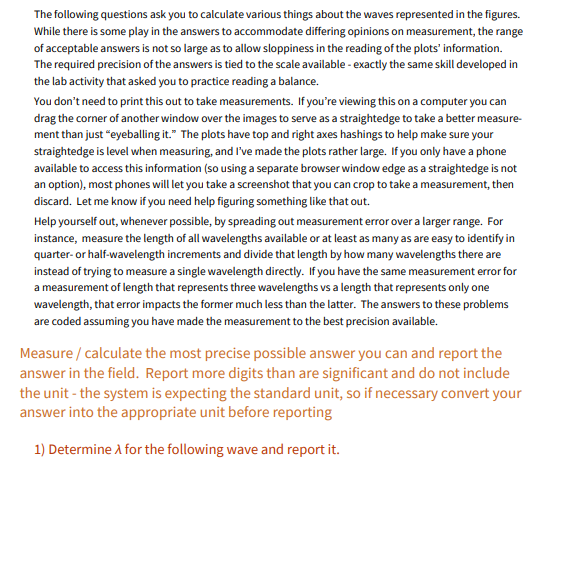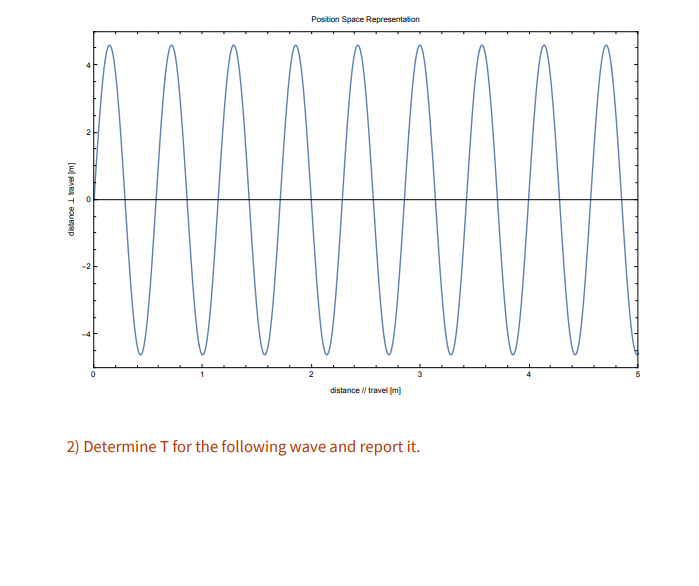University Physics Volume 1
18th Edition
ISBN:9781938168277
Author:William Moebs, Samuel J. Ling, Jeff Sanny
Publisher:William Moebs, Samuel J. Ling, Jeff Sanny
Chapter16: Waves
Section: Chapter Questions
Problem 137AP: A trough with dimensions 10.00 meters by 0.10 meters by 0.10 meters is partially filled with water....
Related questions
Question
Thank you

Transcribed Image Text:The following questions ask you to calculate various things about the waves represented in the figures.
While there is some play in the answers to accommodate differing opinions on measurement, the range
of acceptable answers is not so large as to allow sloppiness in the reading of the plots' information.
The required precision of the answers is tied to the scale available - exactly the same skill developed in
the lab activity that asked you to practice reading a balance.
You don't need to print this out to take measurements. If you're viewing this on a computer you can
drag the corner of another window over the images to serve as a straightedge to take a better measure-
ment than just "eyeballing it." The plots have top and right axes hashings to help make sure your
straightedge is level when measuring, and I've made the plots rather large. If you only have a phone
available to access this information (so using a separate browser window edge as a straightedge is not
an option), most phones will let you take a screenshot that you can crop to take a measurement, then
discard. Let me know if you need help figuring something like that out.
Help yourself out, whenever possible, by spreading out measurement error over a larger range. For
instance, measure the length of all wavelengths available or at least as many as are easy to identify in
quarter- or half-wavelength increments and divide that length by how many wavelengths there are
instead of trying to measure a single wavelength directly. If you have the same measurement error for
a measurement of length that represents three wavelengths vs a length that represents only one
wavelength, that error impacts the former much less than the latter. The answers to these problems
are coded assuming you have made the measurement to the best precision available.
Measure / calculate the most precise possible answer you can and report the
answer in the field. Report more digits than are significant and do not include
the unit - the system is expecting the standard unit, so if necessary convert your
answer into the appropriate unit before reporting
1) Determine A for the following wave and report it.

Transcribed Image Text:Position Space Representation
distance / travel (m)
2) Determine T for the following wave and report it.
Expert Solution
This question has been solved!
Explore an expertly crafted, step-by-step solution for a thorough understanding of key concepts.
Step by step
Solved in 2 steps

Knowledge Booster
Learn more about
Need a deep-dive on the concept behind this application? Look no further. Learn more about this topic, physics and related others by exploring similar questions and additional content below.Recommended textbooks for you

University Physics Volume 1
Physics
ISBN:
9781938168277
Author:
William Moebs, Samuel J. Ling, Jeff Sanny
Publisher:
OpenStax - Rice University

Physics for Scientists and Engineers
Physics
ISBN:
9781337553278
Author:
Raymond A. Serway, John W. Jewett
Publisher:
Cengage Learning

Physics for Scientists and Engineers with Modern …
Physics
ISBN:
9781337553292
Author:
Raymond A. Serway, John W. Jewett
Publisher:
Cengage Learning

University Physics Volume 1
Physics
ISBN:
9781938168277
Author:
William Moebs, Samuel J. Ling, Jeff Sanny
Publisher:
OpenStax - Rice University

Physics for Scientists and Engineers
Physics
ISBN:
9781337553278
Author:
Raymond A. Serway, John W. Jewett
Publisher:
Cengage Learning

Physics for Scientists and Engineers with Modern …
Physics
ISBN:
9781337553292
Author:
Raymond A. Serway, John W. Jewett
Publisher:
Cengage Learning

Physics for Scientists and Engineers, Technology …
Physics
ISBN:
9781305116399
Author:
Raymond A. Serway, John W. Jewett
Publisher:
Cengage Learning

Physics for Scientists and Engineers: Foundations…
Physics
ISBN:
9781133939146
Author:
Katz, Debora M.
Publisher:
Cengage Learning
